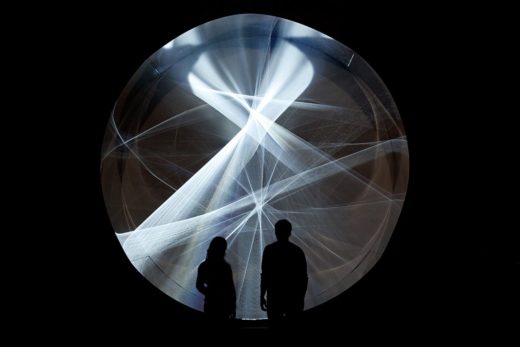- Midnight Thrift

- A New Day Has Come: A Review of Radical Hope: Letters of Love and Dissent in Dangerous Times
Julio Le Parc: Form Into Action
Ricardo Mor
 Continuel-lumière cylindre (Continuous Light Cylinder)
Continuel-lumière cylindre (Continuous Light Cylinder)
November 18, 2016–March 19, 2017
In Julio Le Parc: Form into Action, the eye does not have a moment to rest. The exhibition is a wide-reaching retrospective of the Argentinian artist, who was born in 1928 and would engage actively in the realms of participatory and kinetic art throughout his career. Le Parc challenged the notion of an “absolute, fixed work of art” and his practice sought to create works that would turn spectators into active participants rather than passive viewers. The resulting works are visually arresting, but it is likely the manifesto statement that he would co-author with the artist collective GRAV (Groupe de Recherche d’Art Visuel) that best defines his oeuvre: “It is impossible not to participate.”
Le Parc worked in a variety of capacities, but the exhibition introduces the artist first with his interventions within the two-dimensional realm of painting and works on paper. Monochromatic grids of shapes oscillate and reverberate with eye trickery characteristic of Op Art. His color-drenched works feature prisms of hues in ribbons and waves or coalescing in radiant pointillist fields and forms. His series Contortions and Déplacements (Displacements) would further his experimentation of the picture plane. With Contortions, he created works that were activated by motorized elements, such as metal strips that shift and bend. Displacements forces viewers to move along the works to see their movement through the use of refractory mirrors.
The majority of the exhibition is devoted to Le Parc’s light works, a body he hoped would illuminate his viewers to the endless possibilities of medium. Among the most participatory of these works is L’instabilité-Le labyrinthe (Instability-The Labyrinth) (1963/68–2016), a maze of several rooms each with its own environment. The first two rooms showcase light beams trembling and shifting across the space, while the final room forces visitors to walk through a forest of mirrored metal panels. Elsewhere, luminescent waterfalls flood rooms, light refractions bounce off metal cylinders, and iridescent squares of glass and metal cast shadows on the floor and ceilings. Each of these works features seemingly endless variations of light play onto itself, but the breadth of variations in which Le Parc sought to engage with light is remarkable. It is alongside these works that visitors will find the artist’s only self-portrait in the exhibition, a projected image of his smiling face shaking above viewers, the perfect visage of a restless artist whose work was perpetually in motion.
The exhibition culminates in a series of interactive works that requires the viewer’s participation. While their execution might seem closer to arcade fun than rigorous art practice, these works are undoubtedly closest to the artist’s goal for audience involvement. Accept his invitation to push a button and watch as a work begins to clang, bang, shake, twist, or flutter. Step onto his “unstable floor” and feel the ground shift beneath your feet. Look into his mirrors or through his eyeglasses and see yourself and the world around you in a new light.
Ricardo Mor is a curator, writer, and arts administrator based in Miami.








